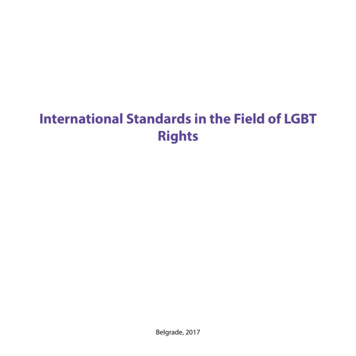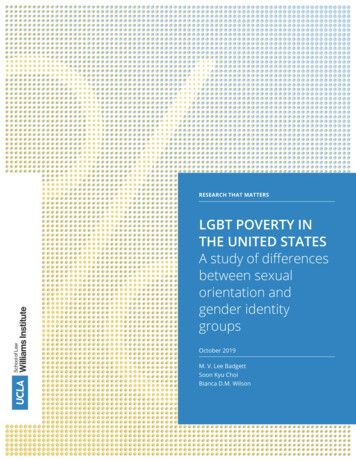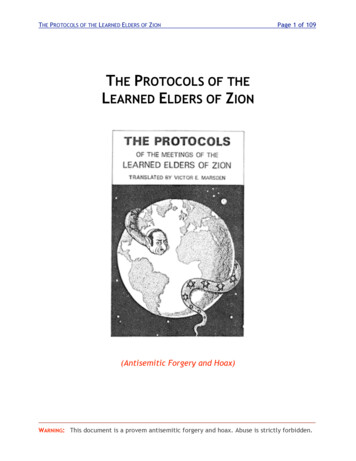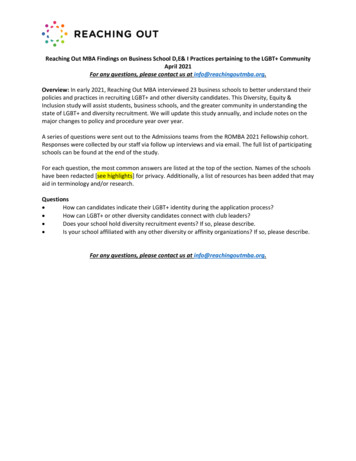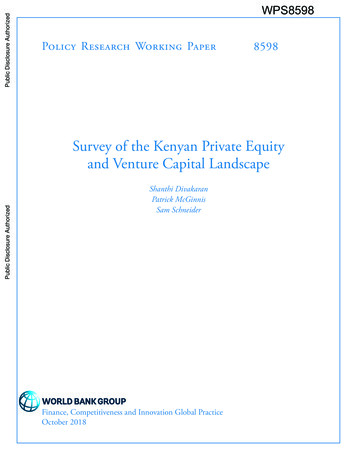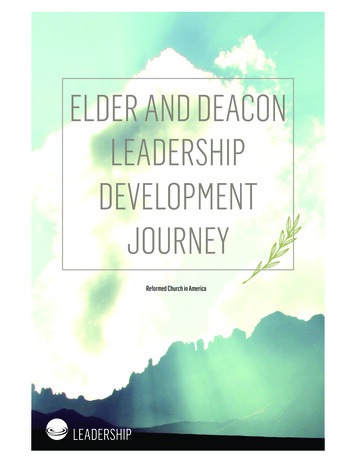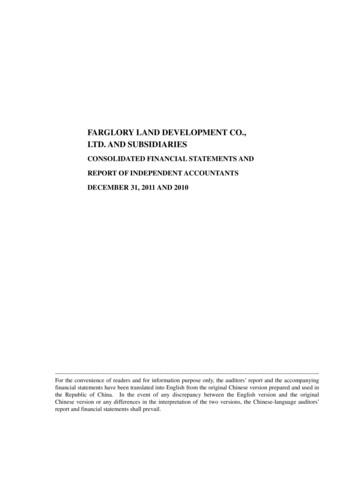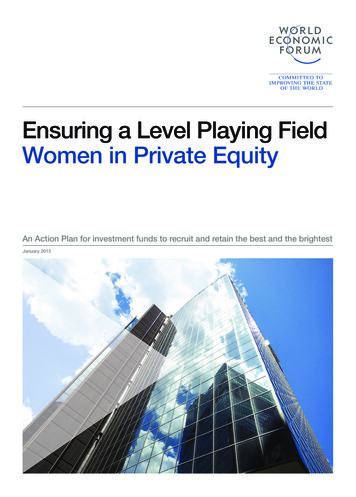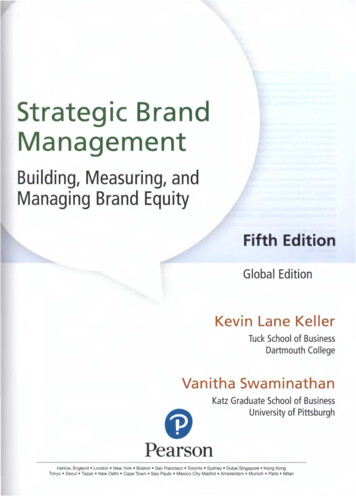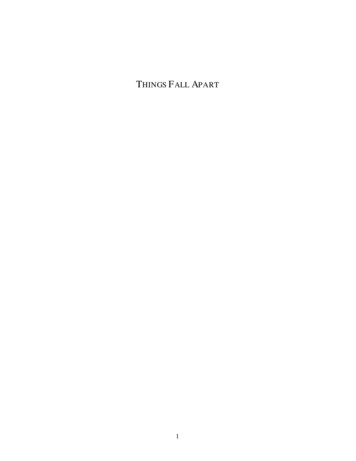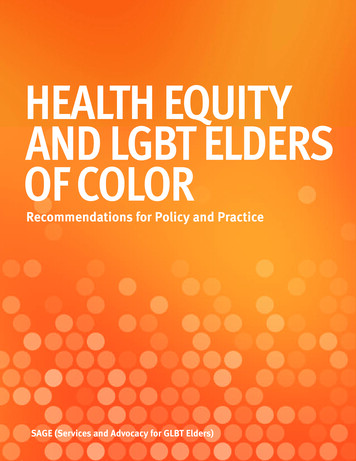
Transcription
HEALTH EQUITYAND LGBT ELDERSOF COLORRecommendations for Policy and PracticeSAGE (Services and Advocacy for GLBT Elders)
TABLE OF CONTENTS1Introduction310 Recommendations4Older Americans Act and LGBT Older Adults7Older Americans Act and Cultural and Linguistic Competence9Federal Funding and Programs for LGBT Elders of Color10Engaging LGBT Communities of Color in Health Reform12Strengthening Social Security for LGBT Older People13Building Data and Knowledge on LGBT Elders of Color14Decreasing Elder Abuse among LGBT Older Adults15Secure and Affordable Housing for LGBT Communities of Color16Federal Support for Older Adults with HIV19Access to Safe and Necessary Care for Transgender Elders20 Appendix: Additional ResourcesACKNOWLEDGEMENTSSAGE is deeply grateful to the many experts who informed this brief,including Mary Anne Adams, ZAMI NOBLA: National Organization ofBlack Lesbians on Aging; Loree Cook-Daniels, FORGE; Dr. Yanira Cruz,National Hispanic Council on Aging; Jeffrey Levi, PhD, Trust for America’sHealth; Jesus Ramirez-Valles, PhD, University of Illinois-Chicago; DouaThor, Southeast Asia Resource Action Center; Daniel Tietz, AIDSCommunity Research Initiative of America; and Harper Jean Tobin, Esq.,National Center for Transgender Equality.AUTHORS:Allison Auldridge andRobert Espinoza, SAGE 2013 SAGE (Services and Advocacy for GLBT Elders)DESIGN: RD Design
IntroductionOver the next several decades, our country will grow increasingly older andmore diverse. Consider the following figures: According to the 2010 U.S. Census, there are more than 40 million adultsWHAT DO WE MEAN BYaged 65 and older in the U.S., a population that will more than double“LGBT ELDERS OF COLOR”?over the next four decades.“LGBT elders of color” is used inthis policy brief to describe lesbian,gay, bisexual and transgender(LGBT) communities of color thatare diverse across race, ethnicity,country of origin, immigrationstatus, sexual orientation, genderidentity, and other characteristics.It also acknowledges thatdifferent communities haveunique policy considerations(e.g., the unique federal statusof American Indians andAlaska Natives, among others).Finally, we interchangeablyuse “elder,” “older adults” and“older people” to capture thediversity of older people acrossgenerations and age brackets(i.e., 50s, 60s, 70s, 80s). By 2050, Latino, Black, Asian and Pacific Islander, and American Indianand Alaska Native people will comprise more than 40 percent of thiselder population.1 The number of lesbian, gay, bisexual and transgender (LGBT) olderadults will more than double in size to roughly 3 million people by 2050.2Faced with these projections, policy makers and service providers around thecountry are increasingly interested in uncovering the best ways to support ourcountry’s rapidly aging population, including those who are most vulnerable topoor health and financial insecurity. LGBT elders of color are an important part ofthis demographic shift—yet the available research shows that they often faceheightened health disparities and are largely rendered invisible in public policydiscussions on aging. Many LGBT elders of color enter retirement age withoutthe supports necessary for healthy aging. And a lifetime of discrimination hasadversely affected LGBT elders of color, based on multiple aspects of theiridentities, including racial inequality, anti-LGBT discrimination, challenges basedon immigration status, and more.For example, employment discrimination has shaped the long-term financialstability of many LGBT elders of color, many of whom are concentrated insectors with low wages, few labor protections, routine discrimination and limitedhealth and savings options. Economic security is core to the health and well-beingof LGBT elders of color.1United States Department of Health and Human Services, Administration on Aging. (2011).Population projections by race and hispanic origin, Persons aged 65 and older [Data file]. Retrievedfrom: http://www.aoa.gov/AoARoot/Aging Statistics/minority aging/Index.aspx2This figure is based on a variety of different studies that have estimated the percentage of gay, lesbian andbisexual people to be between 4 and 8 percent. Few studies have measured the percentage of transgenderpeople. However, measuring the number of LGBT people is difficult, given the undercounting caused byfactors such as stigma, underreporting and a range of methodological barriers, such as inconsistent questionformats. See Williams Institute, UCLA School of Law, Poverty in the Lesbian, Gay and BisexualCommunity. (Los Angeles: Williams Institute, 2009).1
The challenges facing LGBT elders of color intensify as they age into the long-termcare system, where they often find environments that are unwelcome. A 2010national study of aging providers found that only one-third of the respondingagencies had offered staff trainings on LGBT issues.3 Because of the generallack of LGBT-specific cultural competence training and nondiscriminationpolicies in long-term care settings, many LGBT older people fear the ignorance,discrimination and potential abuse they might face from staff and fellow residents.And many LGBT elders of color face additional challenges, encounteringproviders that lack the cultural or linguistic competence to manage their needs,offer few supports in their native languages and lack the knowledge and respectfor their cultural customs.These socio-economic challenges have profound consequences on the health ofLGBT elders of color. According to a 2011 national study on LGBT older adults,LGBT elders of color deal with significant health disparities across areas relatedto physical and mental health, including high blood pressure, cholesterol, diabetes,heart disease, HIV/AIDS and more. This same study found that more thanhalf of LGBT older adults have been told by a doctor that they have depression;39 percent have seriously thought of suicide; and 53 percent feel isolated fromothers.4 In many similar studies documenting the health needs of LGBT people(including elders), LGBT people of color experience the worst outcomes andreceive the least institutional attention. The aging concerns of LGBT elders ofcolor are virtually absent in national policy discussions on aging, health andeconomic security.In order to improve the health and wellness of LGBT elders, we must deal explicitlywith the racial, economic and gender disparities facing LGBT elders of color.As a starting point, this policy brief offers 10 policy recommendations thatcan begin advancing health equity among LGBT elders of color. Not all ofthese recommendations are particular to LGBT elders of color; we recognizethat as communities living with multiple identities and dealing with barriersrooted in various forms of discrimination, LGBT elders of color benefit frompolicy improvements that address the challenges they face as LGBT peopleand as people of color. More broadly, we believe that when we strengthenthe health supports for the most vulnerable people, we strengthen the healthsystem for all people.23Knochel, K.A., Crogan, C.F, Moore, R.P., & Quam, J. (2011). Ready to Serve? The Aging Network andLGB and T Older Adults. Washington, DC: National Association of Area Agencies on Aging.4Fredriksen-Goldsen, K. I., Kim, H.-J., Emlet, C. A., Muraco, A., Erosheva, E. A., Hoy-Ellis, C. P.,Goldsen, J., Petry, H. (2011). The Aging and Health Report: Disparities and Resilience among Lesbian, Gay,Bisexual, and Transgender Older Adults. Seattle: Institute for Multigenerational Health.
10 Recommendations1Older Americans Act and LGBTOlder Adults . 42Older Americans Act and Culturaland Linguistic Competence . 73Federal Funding and Programs forLGBT Elders of Color. 94Engaging LGBT Communities of Colorin Health Reform . 105Strengthening Social Securityfor LGBT Older People . 126Building Data and Knowledgeon LGBT Elders of Color. 137Decreasing Elder Abuse amongLGBT Older Adults . 148Secure and Affordable Housing forLGBT Communities of Color. 159Federal Support for Older Adultswith HIV. 1610Access to Safe and Necessary Carefor Transgender Elders . 193
1Include specific provisions for LGBT elders in theOlder Americans Act (OAA), ensuring that vulnerableLGBT elders of color are able to age in good healthand with broad community supportThe OAA serves as the country's leading vehicle for delivering services to olderpeople nationwide, providing more than 2 billion annually in nutrition andsocial services. Unfortunately, little OAA funding goes to programs that explicitlytarget LGBT older people. Since its enactment in 1965, the OAA has placed itsemphasis on vulnerable elders who face challenges related to social isolation. Yetdespite ample evidence of their heightened vulnerability and their need for uniqueaging supports, LGBT older people are absent from this landmark law. As theOAA comes up for reauthorization, and as millions of LGBT people enterretirement age, Congress has an opportunity to ensure that the OAA supports allelders, including LGBT older people—and in particular, LGBT elders of color.SAGE RECOMMENDATIONS: Ensure that the reauthorization of the OAAincorporates the amendments proposed in the “LGBT Elder Americans Act,”which would include LGBT older adults as a vulnerable population with greatesteconomic and social need; permanently establish SAGE’s National ResourceCenter on LGBT Aging, the country's first and only national technical assistanceresource center aimed at improving the quality of services and supports offered toLGBT older adults; improve data collection and analysis on the effectiveness ofthe state units on aging in targeting services to LGBT older adults; and prioritizeresearch and development grants for organizations working to improve LGBThealth. To learn more about LGBT older people and the OAA, please visitsageusa.org/oaa.4
Southeast Asian American elders struggle withissues such as lack of culturally and linguisticallyappropriate care, health disparities and wealthand income equality. These issues are not isolated,as elders of color and diverse elders who liveat the intersections of community and identity facedisproportionate barriers to accessing neededprograms and services. SEARAC strongly supportsthe recommendations in this policy brief – a moreinclusive aging services network will result in strongerhealth outcomes and a higher quality of life for LGBTelders of color. Furthermore, as the United Statestransitions to a country that is older, as well as morediverse, the recommendations laid out in this policybrief detail critical and needed policy reforms toensure that the aging services network in thiscountry is inclusive to the needs of diverse elders.DOUA THOR, Executive DirectorSoutheast Asia Resource Action Center (SEARAC)5
In 2010, SAGE helped co-found the Diverse Elders Coalition(DEC), a federal advocacy coalition made up of five nationalorganizations representing millions of elders of color andLGBT elders. The DEC focuses on strengthening policies andprograms to enhance the health and well-being of diverse elders,educating and connecting our older people and their loved onesto key policy debates on aging, and increasing public supportfor issues that affect our communities.Since its inception, the DEC has garnered considerableattention and moved key policy wins at the federal level.Over time the coalition has focused on various areas of sharedinterest, including strengthening Social Security and educatingour communities about the program; increasing funding forprograms aimed at more marginalized elders (largely throughimplementation of the Affordable Care Act); and ensuringthat the Older Americans Act , through reauthorization,directs more of its sizable resources to marginalized olderadults around the country.In 2011, the DEC led two successful advocacy efforts.In April of that year, the coalition worked with the influentialLeadership Council of Aging Organizations (LCAO)—aconsortium of more than 65 leading national agingorganizations—to issue eight recommendations supportiveof LGBT elders and elders of color in the LCAO’s “consensusdocument” for reauthorization of the Older Americans Act.From December 2010 to March 2011, policy leaders fromthe DEC met regularly with the sub-committee of theLCAO assigned to produce this committee. By March, thefull Council had voted in support of the recommendationsoffered by the Diverse Elders Coalition.6And a few months later inJune 2011, the coalitionsuccessfully advised the NationalPrevention, Health Promotion, andPublic Health Council—an entityestablished through health care reform—on its National Prevention Strategy to make itmore inclusive of diverse older people. Thecoalition first submitted a research memo in early2011 to the National Prevention Council that detailedthe numerous health disparities facing elders ofcolor and LGBT elders. A few months later, the coalitionfollowed up with six precise recommendations.When the National Prevention Council released itsNational Prevention Strategy in June 2011, the coalition sawseveral of its recommendations integrated into theadministration’s large-scale, multi-year health plan, includingvarious references to age, sexual orientation, cultural andlinguistic competence, and the need to address healthdisparities—all of which made this preeminent documentmore responsive to elders of color and LGBT elders.In July 2012, the coalition released a policy report, “SecuringOur Future: Advancing Economic Security for Diverse Elders,”and news blog on the issues facing LGBT elders and elders ofcolor, and engaged in advocacy with Congressional membersthrough a briefing. It continues to play a valuable role inWashington, DC on the key issues affecting diverse olderpeople. It remains focused on health reform implementation,Social Security and the Older AmericansAct reauthorization.The Diverse Elders Coalitionincludes: the NationalAsian Pacific Centeron Aging, the NationalHispanic Council onAging, the NationalIndian Councilon Aging, Servicesand Advocacy forGLBT Elders (SAGE)and Southeast AsiaResource Action Center.SAGE ANDTHE DIVERSEELDERSCOALITIONTo learn more about theDiverse Elders Coalition, pleasevisit diverseelders.org.6
Ensure that community services and supportsin the Older Americans Act (OAA) are offeredin a culturally and linguistically competent manner,better reaching LGBT elders of color2Approximately one in five older Americans over age 65 is a person of color andmany speak English as a second language. For example, according to the NationalAsian Pacific Center on Aging, 60 percent of Asian and Pacific Islander (API)people age 65 and older have limited English proficiency—a concern that willbecome more pressing as the number of API elders grows from 1.6 million to7.6 million by 2050.5 Likewise, Latino older adults experience multiple culturaland linguistic barriers to receiving needed services; by 2050, Latino older adultswill make up 20 percent of the older adult population in the U.S.6 The OAAmust evolve to meet the cultural and linguistic needs of elders of color to ensurethat all its services are equitably accessed. Collaborating with community-basedorganizations that work with communities of color and LGBT communities isessential to creating culturally and linguistically competent services.“The face and culture of ourelder population ischanging. Their diversity isincreasing. Black, Latino,Native American, and AsianLGBT older adults arejoining the ranks. In thesame manner our policiesneed to change. There is anurgent need for sensitivepolicy change to reduceand prevent furthermarginalization of agingLGBT people of color.”SAGE RECOMMENDATIONS: Enact the amendments introduced in the“Improving Services and Activities for Diverse Elders Act”—introduced in 2012by Senator Michael Bennet (D-CO)—which would ensure that communityservices and supports in the OAA are offered in a culturally and linguisticallycompetent manner by assessing State and Area plans on aging; require that theAssistant Secretary on Aging consult community-based organizations thatspecialize in working with low-income minorities to develop technical assistanceframeworks, staff trainings and other forms of instruction; define culturally andlinguistically competent services as an OAA objective; and urge states to provideculturally and linguistically appropriate resources on cases related to elder abuse.JESUS RAMIREZ-VALLES, PHDUniversity of Illinois-Chicago5Administration on Aging. (2010) A Statistical Profile of Asian Older Americans Aged 65 . Retrieved from:http://www.aoa.gov/Aging Statistics/minority aging/Facts-on-API-Elderly2008-plain format.aspx6Administration on Aging. (2010) A Statistical Profile of Hispanic Older Americans Aged 65 . Retrievedfrom: http://www.aoa.gov/Aging Statistics/minority aging/Facts-on-Hispanic-Elderly.aspx7
The diversification and exponential growth of theU.S. aging population demands an equivalentresponse and shift in terms of public policy andpractice. Yet, we see diverse older adults facingdisproportionate inequities that inhibit them fromliving their golden years with economic securityand in the best health possible. Through groundbreaking research, NHCOA has discovered that amongthose in greatest need are Latino LGBT seniors whoremain absent when it comes to addressing theseissues at the local and national level.DR. YANIRA CRUZ, President and CEONational Hispanic Council on Aging (NHCOA)8
3Increase federal funding for organizations andprogrammatic interventions targeting LGBT eldersof colorAs the need for supportive aging services continuously grows, manyorganizations serving elders of color and LGBT elders struggle to access fundingfor their critical programs. These organizations provide a range of essentialservices to their communities, at the local, state and national levels. And manyof these unique supports are offered for free or at low-cost to reach poor andlow-income older people. In order to ensure that all older people are able toaccess critical services, increased funding must be allocated to organizations andprograms that target older adults who are LGBT and/or people of color.SAGE RECOMMENDATIONS: The Administration on Aging (AoA) shouldamend regulations to add nondiscrimination protections on the grounds ofsexual orientation and gender identity to grant criteria for key OAA-fundedprograms. AoA should issue immediate guidance to its grant recipients clarifyingtheir obligations to marginalized communities of older people. AoA shouldrecommend next steps that will help ensure that all eligible older adults haveaccess to needed services, particularly vulnerable LGBT elders of color. Otherfederal agencies throughout the U.S. Department of Health and HumanServices should exercise their authority to support programs that target LGBTolder people and elders of color.9
Ensure that implementation of the AffordableCare Act engages LGBT elders of color as advocates,so that new health reforms effectively reachcommunities of color and LGBT communities that aredealing with aging challenges4The Affordable Care Act (or ACA) provides numerous opportunities to addresshealth disparities among LGBT elders of color. For example, the expansion ofMedicaid and private insurance coverage, as well as the prioritization of preventivecare, will have profound impacts on the health of marginalized older people.Further, beneficiaries who are dually eligible for Medicaid and Medicare are lowincome and elderly/disabled individuals—and more likely to be women of color.7As key healthcare reforms are implemented by state
2013 SAGE (Services and Advocacy for GLBT Elders) ACKNOWLEDGEMENTS SAGE is deeply grateful to the many experts who informed this brief, including Mary Anne Adams, ZAMI NOBLA: National Organization of . Older Americans Act (OAA), ensuring that vulne
